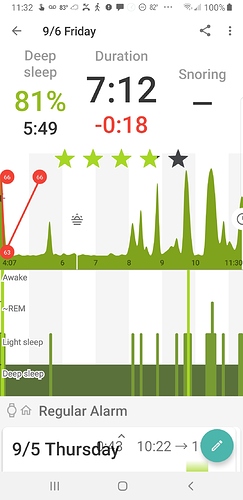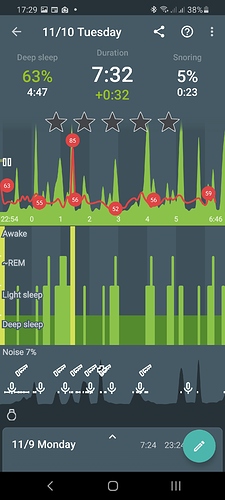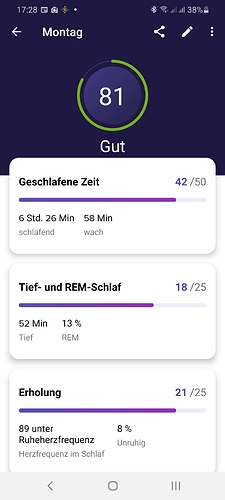So my deep sleep percentage has been around 40-45ish. The average for the US seems to be 50ish according to SAA data. I shared that with a friend of mine that has a Fitbit. He was surprised to hear that and said that his % is around 20-25, and that that’s around normal. I got curious and looked around the internet, and pretty much all info says that normal deep sleep is about 10-25% (example: https://www.healthline.com/health/how-much-deep-sleep-do-you-need). So how come SAA’s deep shows as much higher than what should be typical? I’m sure there is a good explanation 
My guess is that it has to do with there being 2 stages of “light” sleep, one much deeper than the other. So, it’s a judgement call as to where to put stage 2 sleep. True Delta wave sleep is relatively brief, but including stage 2 sleep in “deep” gives people a better picture of their night, I think.
Perhaps those charts will help.
In other words, without eeg sensors, it’s a guessing game between stages 2 and 3. But in both, the sleeper has fallen into a deeper sleep than stage 1 light sleep. To attempt a guess at true Delta wave sleep is perhaps disingenuous, whereas SaA includes both theta wave and delta wave sleep in the deep rather than light sleep category. In both cases, HR and body temperature drop and brain waves fundamentally change.
I thought the answer would be something like this. It would be nice if the devs could chime in as well though.
Yes, I also would be interested in their point of view.
UPDATE: the past week, I am getting unusually large deep sleep percentages, like 72%. It’s either me, or something has changed with recent updates. I am a beta tester.
Although I am not sleeping long enough for optimal benefit and so that pushes you into more deep sleep, getting percentages above 70 is not even close to normal. This might be something to look into. I will check sleep cloud to see a possible trend.
Hellooo! It’s still happening. Like 77% deep. Too often. Either something is wrong with me and I am nearly comatose, or there’s a bug that needs squashing.
I admit that I am staying up too late doing financial work and learning to code in 21st century languages, which is a whole 'nother order of coding from what I used to do and requires concentration. And job hunting at night. Etc. Etc. Poor sleep habits. But! That’s just too much deep sleep being counted by the algorithm. And it’s missing some intense REM as well. If I wake up to the alarm from a strong dream, ideally, that should be picked up. If I could edit the graph to at least indicate that I was awakened in REM, that’s something a sleep doctor might want to see. And I intend to see one shortly because I am having difficulty sleeping properly. I know the rules of sleep hygiene, but they are hard to follow. Staying up too late. I need a voice and app to turn EVERYTHING OFF! I have a warning notification, but it’s easy to ignore. I will browse the play store for something less work than Tasker. Hue lights, out, WiFi and Data, off, TV Off, etc., etc. Because this is not insomnia. It’s night owl syndrome.
I sleep when I’m utterly exhausted and plunge right into deep sleep.
If the app can do a soft-sided EEG headband, the actual brainwaves could be used. That would end all doubt. But they are almost ALL hard bodied and only good for meditation or if you sleep on your back. I hear rumblings that it might be on the to-do list. The only change from existing monitors is wrapping them in foam. And they cost a fortune!!! Ouch.
SAA - the first app to detect the zombie apocalypse :))
Funny, but my request is actually serious. Goodnight. Cause that’s how we roll. Over. 
For most adults, REM takes up about 20 to 25 percentTrusted Source of sleep, and this seems to be healthy during average sleep cycles. However, sleep research is raising some interesting questions. One recent study suggested that higher amounts of REM sleep may be associated with depression. But don’t go making sudden changes in your sleep habits — it is not clear which is the cause and which is the effect.
Assuming a person sleeps for 8 hours, 13 % to 23% is allocated as deep sleep.Most probably, 62 to 110 minutes.
I think there is something wrong with the tracking, mine is normally showing around 90% with little to no REM or light sleep. I’m trying to figure out how to remedy this.
If this is still happening, how long is your total duration? If it’s very short, this can happen. Especially if you’ve been sleep deprived. Just curious because this sometimes happens to me. Thanks.
To everyone with this issue, have you guys tried turning up the sensitivity of the sensors in the app? Perhaps they’re just not sensitive enough. Also, if you’re using the accelerometer, do you guys have a firm bed? Or even one of those mattresses made of material that doesn’t transfer much movement (such as memory foam)?
With all the tracking options available, I would think putting a powerful lithium ion battery in your bed while you sleep would be the LAST option. If you don’t do that, the type of mattress doesn’t matter. I am SO glad that 5 years ago, I got a great wearable. I never put a phone in my bed again. And the accuracy is so much better. (I use a Pebble Time. I have 3 of them, all decorated distinctly in accordance with the color and what I like.)
If you use Sonar, Sleep Phaser or a wearable, try turning up the sensitivity all the way on awake events, especially. The sensor would then be told to be on high alert for any motion during sleep.
I just discovered this thread. On my Fitbit Sense I usually get around 20% of deep sleep and REM sleep combined. When I use SaA with my Galaxy Active 2 it usually claims around 70%. That’s a huge difference.
Tonight I will compare again and post the results tomorrow.
Sleep says Deep Sleep: 63 %
Fitbit Sense: 13 %
Weird.
Not really weird. There are two stages of light sleep N1 and N2. N3 is actually deep, slow wave sleep.
Without an EEG, it’s almost impossible, except by guess, to tell N2 from N3. So it appears that SaA combines N2 and N3. There is also Awake and just barely asleep: N1, where your mind and body are winding down into sleep. And then there’s REM, in which movement is very important. Although one is “paralyzed” by REM, and there is very little movement, there IS movement: twitches and jerky movements. SaA extrapolates from this data that you are in REM sleep. It’s not slow wave deep sleep.
So, basically the other apps try to guess N3 slow wave deep sleep. And that’s not accurate. It gives the appearance of accuracy, but it’s not. The developers have decided, apparently, to combine N2 and N3. That leads to a higher percentage. It says “deep” but doesn’t guess about your brain waves. When there is a comfortable and affordable EEG sensor, then you’ll get the actual brain waves.
I was just reading up on it yesterday. Something to do on a Sunday in the Time of Corona.
Hope that offers my interpretation of why SaA has higher percentages. I am not one of the developers, but I am a Ph.D. sociologist and thus able to interpret data sets and try to figure out what they may mean.


